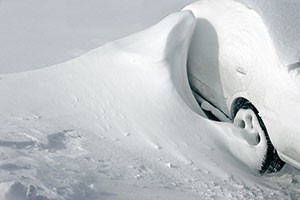Winter Storm On The Way? Plan Now.

According to the National Weather Service, about 25 percent of injuries during winter storms result from being caught in the harsh weather. Employers can help workers prepare for emergencies by providing safety training and emergency supplies.
To prevent crews from becoming stranded while traveling in poor winter weather, it is important to maintain vehicles properly. The Occupational Safety and Health Administration (OSHA) recommends employers regularly inspect each work vehicle to ensure:
• Even, balanced braking and the proper brake fluid levels
• The correct level and mix of antifreeze and water is in the cooling system, and oil, windshield washer, and other fluids are at proper levels
• The battery is fully charged, connections are clean, and the alternator is in good working condition
• All engine systems are working properly
• The exhaust is not leaking and clamps and hangers are secure
• Tires are evenly worn, not damaged, and have an appropriate tread depth
• Exterior and interior lights, defrosters, and wipers work
• Winter windshield wipers have been installed
OSHA also advises employers to safeguard workers during snow storms by providing crews with the emergency supplies they will need if stranded. Stock each work vehicle with the following: flares, jumper cables, snacks, water, road maps, blankets or sleeping bags, a cell phone or two-way radio, a windshield scraper, a snow brush, flashlights and batteries, a shovel, warm protective clothing, a tow chain, matches, and traction aids, like a bag of sand or kitty litter. Before workers leave to travel in a storm, ensure they are appropriately dressed with warm work gloves, jackets, and work boots.
According to OSHA, if workers become stranded while on the job, they should:
• Stay inside the vehicle unless help can be seen within 100 yards because they could become disoriented and lost in blowing, drifting snow
• Indicate help is needed by raising the vehicle’s hood and hanging a distress signal on the radio antenna, such as a brightly colored cloth or article of clothing
• Run the engine and heat for 10 minutes each hour to keep warm
• Turn on the dome light when the vehicle is running as another signal of distress for travelers passing by
• Exercise caution to prevent carbon monoxide poisoning. Ensure the exhaust pipe is not blocked by drifting snow and crack open a downwind window for ventilation
• If more than one person is stranded, take turns sleeping and huddle together for warmth
• Use anything available for additional insulation, such as newspapers, maps, and removable car mats
• Keep circulation up by performing minor exercises like clapping hands and occasionally moving arms and legs. Don’t stay immobile or in one position for too long. Watch for any symptoms of frostbite and hypothermia
• Since cold weather exerts additional strain on the heart, avoid overexertion when attempting to move snow or push a vehicle. These activities could cause a heart attack or worsen existing health issues
• Watch for signs of dehydration
Many jobs require workers to travel during winter storms. Take precautions to protect these employees by providing the supplies, knowledge, and training to stay safe if stranded during a winter storm.



